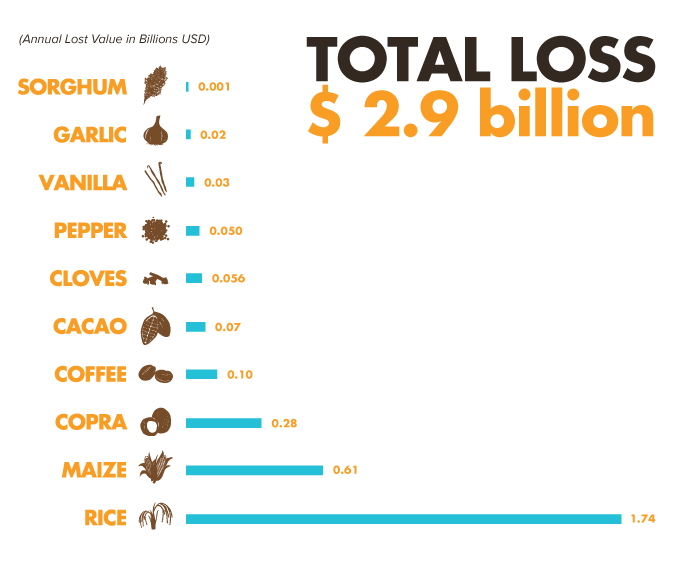In our latest agricultural research, we wanted to better understand the post-harvest challenges faced by smallholder farmers in Indonesia. By interviewing farmers and other stakeholders, we found that ineffective crop drying techniques - a common step in the value chain of many commodities - are one of the major causes of economic losses in the agricultural sector. Farmers typically dry their crops under the sun, a process which is inconsistent, sometimes unhygienic, and can take many weeks to complete. We wanted to monetize the scale of these losses by taking into account the commodities’ national production volume, selling price, and the estimated proportion of damage caused by drying.1
Across the ten commodities studied, we estimate the loss to the sector in Indonesia amounting to almost USD$3 billion
Estimated monetary losses due to ineffective drying2

If we were to take into account additional costs further along the value chain, the total economic losses, as a result of ineffective drying, are likely to be even greater. How? We believe that improper drying is the root of many evils as it contributes to further losses in the subsequent steps of the post-harvest practices such as processing and storing of crops. For example, unmilled rice grains (“gabah”) which have a high level of moisture caused by ineffective drying, attract more weevils when stored, compared to those that are dried properly.
Therefore, tackling ineffective drying practices could be an important entry point to improving farmers’ livelihoods and one that is likely to result in higher quality and value of commodities sold by Indonesia’s smallholder farmers. Better drying, enabled by improved drying technologies can lead to higher incomes for farmers, greater control over their time and activities, and a reduction in their vulnerability to external factors such as weather conditions.
What kind of solutions do you think can help smallholder farmers make the crop drying process more effective?
If you are interested in learning more about the social and economic opportunities for smallholder farmers, Kopernik will host a report launching event in Bali on the 10 of March 2017. The Unmet Needs report highlights gaps in the agricultural sector for smallholder farmers in Indonesia. During the event, we will discuss potential solutions and opportunities for collaboration with some of the key players within the Indonesian agricultural sector. Click here for more information.
2. The losses are calculated using an exchange rate of 1 USD = Rp. 13,082 (as per 7 November 2016). Source: Kopernik’s Unmet Needs Report 2016.


